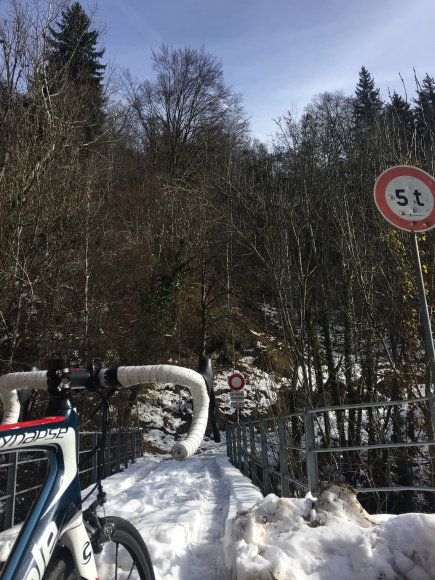Just because winter is upon us, it doesn’t mean we should stop riding. As long as the roads are dry, I plan to keep getting out there – plus adding some skiing to the mix in the new year. Fat bikes, gravel, CX, and MTB are one way to get around the problem. Unfortunately, with only one bike in my current arsenal, I’ll just be following the sun and hoping for the best.
Mid-November surprised us with an early snow dump in the Tarentaise, and we got several inches on the ground as low down as Fontaine. But with bluebird skies, I couldn’t resist a morning spin in the sunshine, even if the thermometer read -2C. But I kept it to the sunny side of the valley, where the roads were dry and snow melt had evaporated, rather than turned to ice.

Cycling in the winter in many ways is not so different from riding at any other time of the year. As they say, “there’s no such thing as bad weather, just bad clothing.” This means:
1. insulated tights: leg warmers are fine if it’s not particularly cold but they won’t insulate your bottom, and they can be uncomfortable, and they’re pretty unstylish (like most winter cycling gear), and I find that any splash-back from wet patches immediately penetrates the thin summer lycra. Or get some thermal bib shorts to match!
2. insulated, waterproof gloves: and for me, with any descents longer than a kilometre or two, I would probably need to add a merino glove underneath as well to keep my thumbs from freezing up. There is nothing worse than having bad gloves. One particularly terrible day on the bike, I was so underdressed that when it started snowing and I was only in shorts and thin, long-fingered spring/autumn gloves, I had to stop three times on a descent to warm up my hands enough to brake. I was also shivering uncontrollably and borderline hypothermic. Lessons learned.
3. buff: handy for descents to keep your neck and mouth (and even nose if you’re particularly chilly and your breath doesn’t steam up your glasses like me). You can double up on the thin buffs or get fleecy ones for colder days. Some also come with holes to increase breathability and avoid the fogging problem.  Personally, I just let my nose get cold.
Personally, I just let my nose get cold.
4. headgear: fleecy cycling beanies and merino caps with ear covers are all the rage and will keep your ears from freezing off.
5. thermal booties: depending on the style of cycling shoes you have, all that lovely summer ventilation will lead to frosty toes in the winter. Make sure they’re tight around the ankles and if you can only have one pair of booties in your entire wardrobe, get thermal & waterproof ones that will do for most conditions. Cold, wet feet are just the pits.
6. layers: keeping your core warm is important but personally, I find that unless it’s supremely cold, then layers are more comfortable as I tend to still get hot on the climbs. In the mountains, you’re going to have more variability (warm on climbs, cold on descents) than if you’re cycling somewhere that’s flat or rolling. Go for merino base layers, fleecy jacket or thermal long-sleeved jersey, and a wind or rain jacket in the back pocket for times when sleet catches you unawares.
Still, the roads can be icy and dangerous. Black ice is often invisible and skidding off the edge of the mountain is a sure way to ruin your off-season enjoyment. So if in doubt, just stay out of shady, wet roads in frosty conditions, stay off the brakes if you can’t avoid rolling through an icy patch, or just head a little lower to where conditions are more favourable. Being outside is always preferable to a day on the trainer in my opinion. And you might find that you actually enjoy being out in the winter. Go on, explore!
